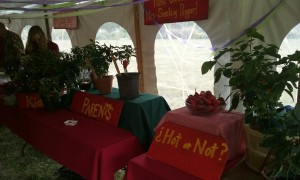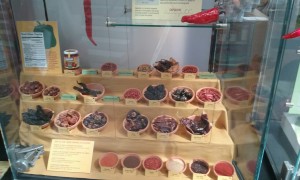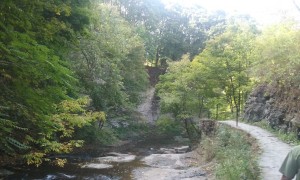
“Pepper? Why pepper?” That is what I first thought when I read about the Pepper Party event. Why would people want to hold an event just about pepper? The only way I could figure this out was by going.
When I arrived at the Cornell Plantations (where the event was taking place), I was surprised to see all the booths set up for the pepper event. I entered a large tent, where I found many different pepper plats on display. The lady at the table told me how she combined 2 different types of peppers by collecting the desired traits of each plant and combining them to make a new pepper plant.
 “I wanted to create a large marbleized sweet pepper by combining a large red hot pepper plant with a small yellow sweet pepper plant. By the third generation, I was able to accomplish this.”
“I wanted to create a large marbleized sweet pepper by combining a large red hot pepper plant with a small yellow sweet pepper plant. By the third generation, I was able to accomplish this.”
She gave me a sample of her “new invention” which tasted like any other sweet pepper you would have on your salad. Probably all the other people who tried the sample thought the same thing.
Next, I went to an indoor booth where a lady was explaining why certain peppers are hotter than others. According to her, the hotness of a pepper is caused by an oily defense chemical called capsaicin. These defense compounds binds to heat receptors that cause a burning sensation when activated. Some compounds bind better than others, which causes certain peppers to be hotter. Since these chemicals are oily, drinking cold water doesn’t help and rather spreads the hotness of the pepper in your mouth.
One thing that I especially found interesting today was about how sunlight affects the hotness of a pepper. When a pepper plant does not receive adequate sunlight, it will produces a less hot pepper. However, when the plants grow in hot and sunny locations, the pepper will be hotter. So heat literally affects the hotness of the pepper!
This Pepper event brought back many memories about my unfortunate experiences with peppers. One experience was when I was eight years old, I accidentally ate two whole cyan peppers that were buried in my food. When I started chewing, I noticed how my mouth started to burn. But by the time I realized that I was eating whole cyan peppers, it was too late. My mouth felt like it was literally on fire. I constantly kept drinking water, not knowing that it was useless. Because the pepper was so hot, my eyes started to water and my body became sweaty. When I wiped the sweat off my face, my eyes started to burn. Somehow, the oil of the pepper got on my hands. After this experience, I never wanted to eat hot peppers again. But over the years, I started to like hot food. Now, Tabasco is the main sauce I use when I eat.
After attending this pepper party event, I feel like I have learned that peppers are actually not as boring as I thought. Rather, they are an interesting and unique species that most people take for granted (including myself). In think that it is important to realize how insignificant things like pepper are actually a major contributor to our food culture. Just think, without peppers we would not have tabasco! 





 “I wanted to create a large marbleized sweet pepper by combining a large red hot pepper plant with a small yellow sweet pepper plant. By the third generation, I was able to accomplish this.”
“I wanted to create a large marbleized sweet pepper by combining a large red hot pepper plant with a small yellow sweet pepper plant. By the third generation, I was able to accomplish this.”
